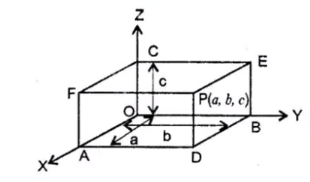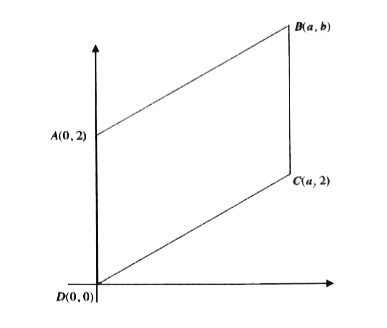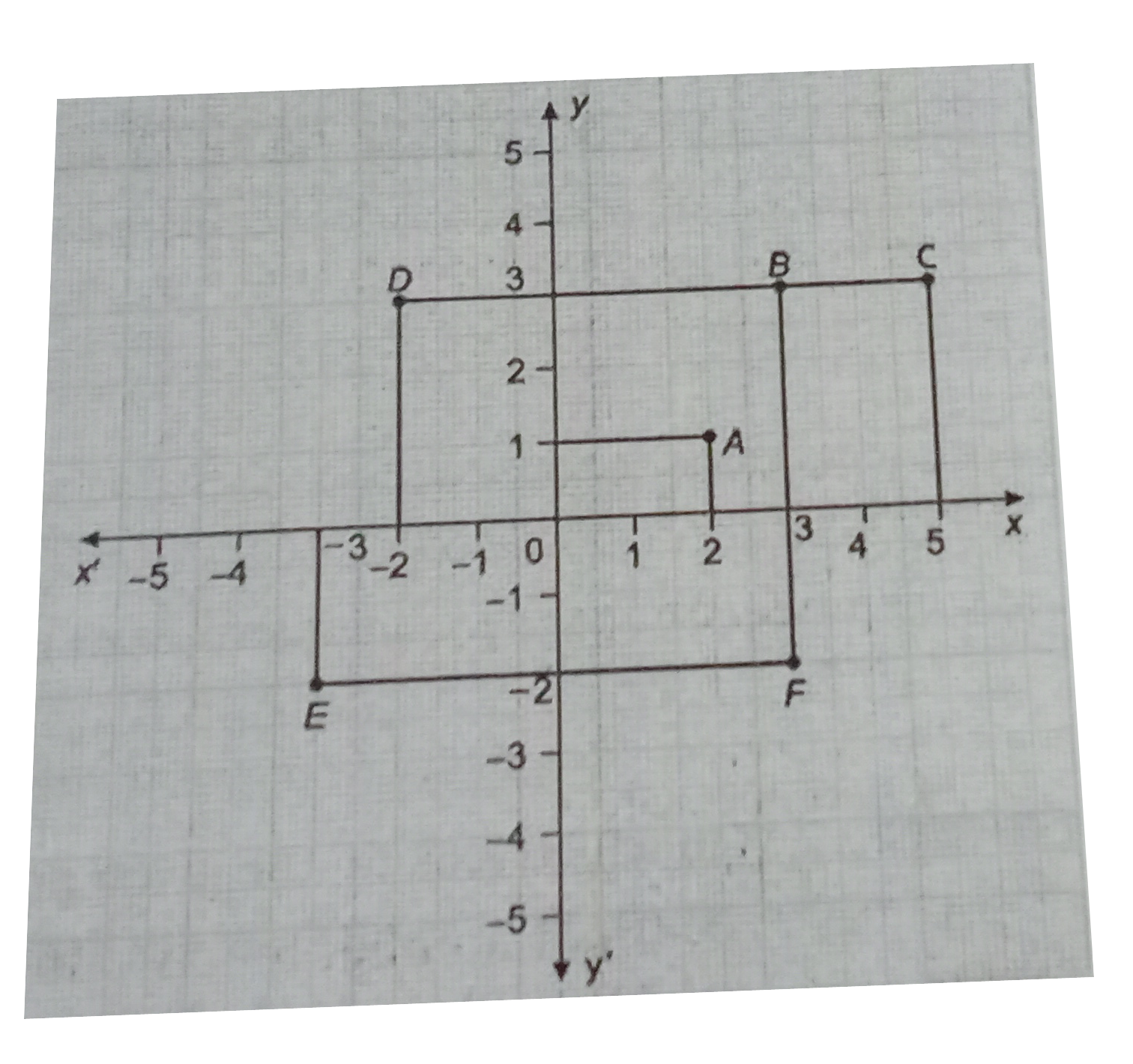In the adoining figure if the coordinates of point P are (a,b,c) write the coordinates of A,B,C,D,E and F.

(a,b,−c),(−a,b,c),(a,−b,c)
(a,−b,−c),(−a,b,−c),(−a,−b,c)
(−a,−b,c),(a,−b,−c),(−a,b,−c)
(a,b,0),(0,b,c),(a,0,c)
The correct Answer is:A
The reflection or image of P(a,b,c) in xy-plane will be as much below the xy-plane as point P is above it that is if P' is the reflection of P in xy-plane then P'D=PD=c and P'D is parallel to OZ'. So, the coordinates of P' are (a,b,−c)
The image of P(a,b,c) in yz-plane will be as much as on the back side of yz-plane as the point P is on its front side. Thus, if P' is the image of P in yz-plane then P'' lies on PE such that PE=EP''.
But PE=OA=a. So the coordinates of P'' are (−a,b,c).
The image of (a,b,c) in zx-plane will be as much as on the left side of xz-plane as the point P is on its right side. Thus, if P''' is the image of P in zx- plane, then P''' lies of PF produced such tht PF=FP'''. But PF=OB=b. So, the cordinates of P''' are (a,−b,c).
Topper's Solved these Questions
- THREE DIMENSIONAL COORDINATE SYSTEM BOOK - OBJECTIVE RD SHARMA ENGLISHCHAPTER - THREE DIMENSIONAL COORDINATE SYSTEM EXERCISE - Section I - Solved Mcqs
16 Videos
- THREE DIMENSIONAL COORDINATE SYSTEM BOOK - OBJECTIVE RD SHARMA ENGLISHCHAPTER - THREE DIMENSIONAL COORDINATE SYSTEM EXERCISE - Exercise
20 Videos
- TANGENTS AND NORMALSBOOK - OBJECTIVE RD SHARMA ENGLISHCHAPTER - TANGENTS AND NORMALSEXERCISE - Chapter Test
25 Videos
- TRIGONOMETRIC EQUATIONS AND INEQUATIONSBOOK - OBJECTIVE RD SHARMA ENGLISHCHAPTER - TRIGONOMETRIC EQUATIONS AND INEQUATIONSEXERCISE - Chapter Test
60 Videos
Similar Questions
Knowledge Check
In the rectangular coordinate system shown, ABCD is a parallogram. If the coordinates of the points A,B,C and D are (0,2),(a,b),(a,2) and (0,0), respectively, then b =
 A0B2C3D4
A0B2C3D4
Use a graph paper for this question taking 1 cm = 1 unit along both the x and y axis:
(i) Plot the points A(0, 5), B(2, 5), C(5, 2), D(5, -2), E(2,-5) and F(0, -5).
(ii) Reflect the points B, C, D and E on the y-axis and name them respectively as B', C', D' and E'.
(iii) Write the coordinates of B', C', D' and E'.
(iv) Name the figure formed by BC DEE'D'C'B'.
(v) Name a line of symmetry for the figure formed.
View SolutionUse a graph paper for this question taking 1 cm = 1 unit along both the x and y axis:
(i) Plot the points A(0, 5), B(2, 5), C(5, 2), D(5, -2), E(2,-5) and F(0, -5).
(ii) Reflect the points B, C, D and E on the y-axis and name them respectively as B', C', D' and E'.
(iii) Write the coordinates of B', C', D' and E'.
View SolutionUse a graph paper for this question taking 1 cm = 1 unit along both the x and y axis:
(i) Plot the points A(0, 5), B(2, 5), C(5, 2), D(5, -2), E(2,-5) and F(0, -5).
(ii) Reflect the points B, C, D and E on the y-axis and name them respectively as B', C', D' and E'.
(iii) Write the coordinates of B', C', D' and E'.
(iv) Name the figure formed by BC DEE'D'C'B'.
View SolutionOrthocenter and circumcenter of a ΔABC are (a,b)and(c,d) , respectively. If the coordinates of the vertex A are (x1,y1), then find the coordinates of the middle point of BC.
View SolutionOrthocenter and circumcenter of a triangleABC are (a,b)and(c,d) , respectively. If the coordinates of the vertex A are (x1,y1), then find the coordinates of the middle point of BC.
View SolutionWrite down the co-ordinates of each points A,B,C,D,E and F as shown in following figure.

View SolutionABCD is parallelogram. If the coordinates of A,B,C are (−2,−1),(3,0) and (1,−2) respectively, find the coordinates of D.
View Solution
